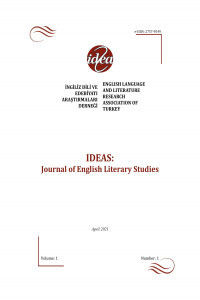From Androgynous to Hybrid Cybernetic Bodies: Salvation or More Subjugation?
From Androgynous to Hybrid Cybernetic Bodies: Salvation or More Subjugation?
Androgynous, Hybrid, Cybernetic Bodies, Jeanette Winterson The Stone Gods,
___
- Balsamo, Anne. “Forms of Technological Embodiment: Reading the Body in Contemporary Culture.” Cyberspace/Cyberbodies/Cyberpunk: Cultures of Technological Embodiment, edited by Mike Featherstone and Roger Burrows, SAGE, 1995, pp. 216–217.
- Bennett, Jane. Vibrant Matter: A Political Ecology of Things. Duke UP, 2010.
- Blum, Virginia. Flesh Wounds: The Culture of Cosmetic Surgery. University of California Press, 2003.
- Braidotti, Rosi. Metamorphoses: Towards a Materialist Theory of Becoming. Polity, 2002.
- Carrasco, Rocío, et al. “Science Fiction and Bodies of the Future: Alternative Gender Realities in Hollywood.” Journal of Futures Studies, vol. 20, no. 2, 2015, pp. 67–80. doi:10.6531/JFS.2015.20(2).A67.
- Daly, Mary. Gyn/Ecology: The Metaphysics of Radical Feminism. The Women’s Press, 1979.
- Deleuze, Gilles, and Félix Guattari. A Thousand Plateaus: Capitalism and Schizophrenia. Continuum, 2004.
- Halberstam, Judith [Jack], and Ira Livingston. Posthuman Bodies. Indiana UP, 1995.
- Hamzah-Osbourne, Shareena Z. “The Smallest Room of One’s Own: Virginia Woolf and Jeanette Winterson in Close Quarters.” Legacies and Lifespans in Contemporary Women’s Writing, edited by Gina Wisker et al. Springer International, 2023, pp. 111–138.
- Haraway, Donna J. Simians, Cyborgs, and Women: The Reinvention of Nature. Free Association, 1991.
- ---. The Haraway Reader. Routledge, 2004.
- Hayles, Katherine N. How We Became Posthuman: Virtual Bodies in Cybernetics, Literature and Informatics. U of Chicago P, 1999.
- Hurst, Rachel Alpha Johnston. “The Skin Textile in Cosmetic Surgery.” Skin, Culture and Psychoanalysis, edited by Sheila L. Cavanagh et al., Palgrave Macmillan, 2013, pp. 141–166.
- Le Guin, Ursula K. “Head Cases | Books.” The Guardian, 22 Sept. 2007, https://www.theguardian.com/books/2007/sep/22/sciencefictionfantasyandhorror.fiction. Accessed 20 Aug. 2023.
- Lokke, Kari Elise. “Orlando and Incandescence: Virginia Woolf’s Comic Sublime.” MFS: Modern Fiction Studies, vol. 38, 1992, pp. 235–252. doi:10.1353/mfs.0.0406.
- Oppermann, Serpil. “From Posthumanism to Posthuman Ecocriticim.” Relations Beyond Anthropocentrism, vol. 4, no. 1, 2016, pp. 23–37. doi:10.7358/rela-2016-001-oppe.
- Pepperell, Robert. The Posthuman Condition: Consciousness beyond the Brain. Intellect, 2003.
- Pickering, Andrew. “Reviewed Works: How We Became Posthuman: Virtual Bodies in Cybernetics, Literature, and Informatics by N. Katherine Hayles: Silicon Second Nature: Culturing Artificial Life in a Digital World by Stefan Helmreich.” Technology and Culture, vol. 41, no. 2, 2000, pp. 392–395.
- Plant, Sadie. “Beyond the Screen: Film, Cyberpunk and Cyberfeminism.” Feminisms, edited by Sandra Kemp and Judith Squires, Oxford UP, 1997, pp. 503–508.
- ---. Zeros and Ones: Digital Women and the New Technoculture. Fourth Estate, 1998.
- Villegas-López, Sonia. “Body Technologies: Posthuman Figurations in Larissa Lai's Salt Fish Girl and Jeanette Winterson's The Stone Gods.” Critique: Studies in Contemporary Fiction, vol. 56, no. 1, 2015, pp. 26–41. doi:10.1080/00111619.2013.843503.
- Winterson, Jeanette. The Stone Gods. Harcourt, 2007.
- ---. “Shape Shifter: The Joyous Transgressions of Virginia Woolf's Orlando.” New Statesman, 18 Feb. 2013, https://www.newstatesman.com/long-reads/2013/02 /shape-shifter-joyous-transgressions-virginia-woolf%E2%80%99s-orlando. Accessed 14 August 2023.
- ---. “On The Stone Gods.” Home | Jeanette Winterson, 8 Oct. 2015, https://www.jeanettewinterson.com/. Accessed 20 Aug. 2023.
- ---. Frankissstein: A Love Story. Jonathan Cape, 2019.
- ---. “I Believe in Human Beings, Even Though They Have Done Some Terrible Things.”” CCCB LAB, 21 January 2020, https://lab.cccb.org/en/jeanette-winterson-i-believe-in-human-beings-even-though-they-have-done-some-terrible-things/. Accessed 20 August 2023.
- ---. Literary Rendezvous at Rue Cambon: Portrait of Virginia Woolf by Jeanette Winterson. 28 Sept. 2021. CHANEL Events, https://www.youtube.com/watch?v=DcgZ1OHk1KY. Accessed 3 May 2023.
- ---. “Is Humanity Smart Enough to Survive Itself? | Jeanette Winterson | TED.” YouTube, 1 Sept. 2022, https://www.youtube.com/watch?v=KYK6Tfb0snQ. Accessed 1 Sept. 2023.
- Woolf, Virginia. A Room of One's Own. Harcourt, 1929.
- ---. The Death of the Moth and Other Essays. Harcourt Brace Jovanovich, 1974.
- ---. Orlando: A Biography. Edited by Maria DiBattista, Harcourt, 2006.
- Başlangıç: 2021
- Yayıncı: İngiliz Dili ve Edebiyatı Araştırmaları Derneği / English Language and Literature Research Association of Turkey
Ruinscapes and Subversion of Temporalities in 'For the Mercy of Water'
“Pocket full of seeds”: A Review of Experiencing Poetry: A Guidebook to Psychopoetics
Thomas Shadwell’in The Libertine Oyununda Abartılan Libertinizmin Bir Eleştirisi
The Chicana Narrator as Healer: Reconciliation in Ana Castillo’s So Far From God
From Androgynous to Hybrid Cybernetic Bodies: Salvation or More Subjugation?
